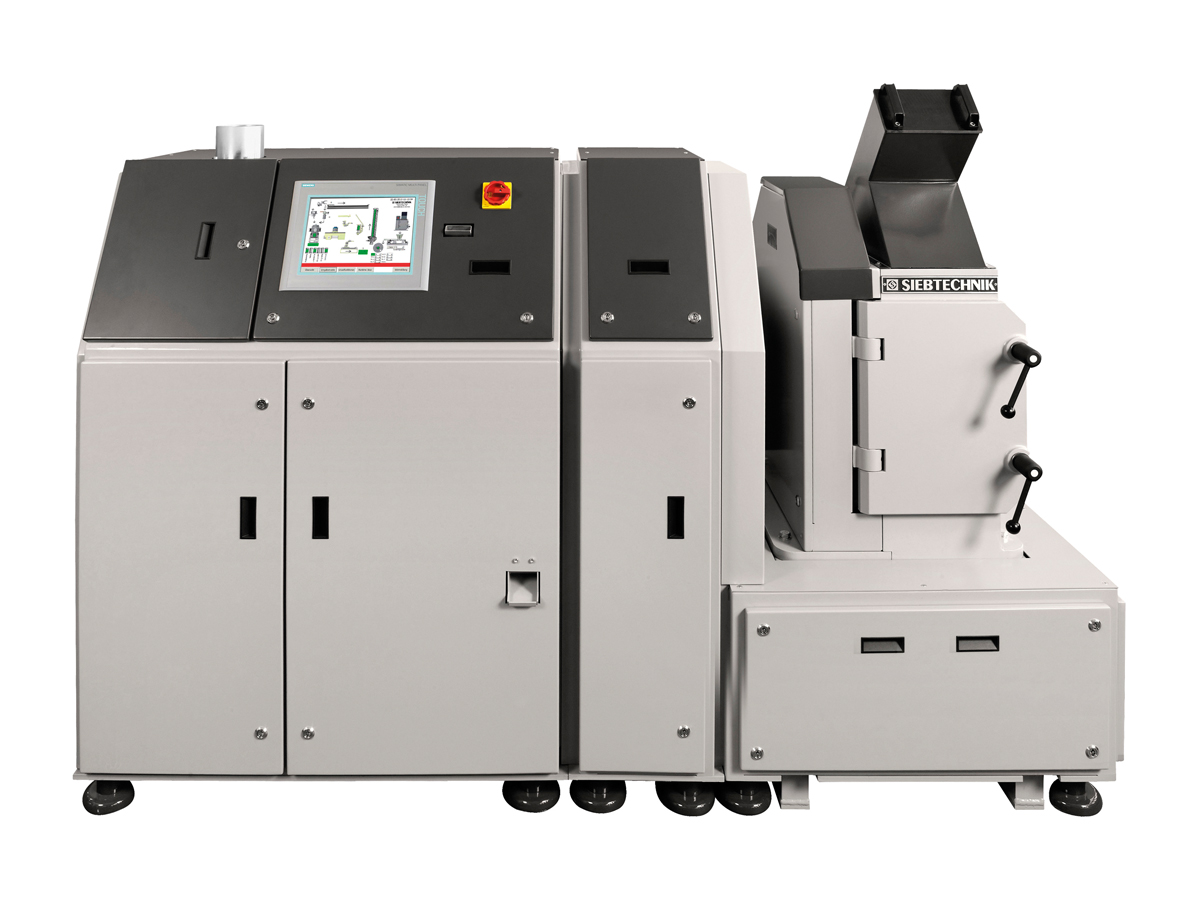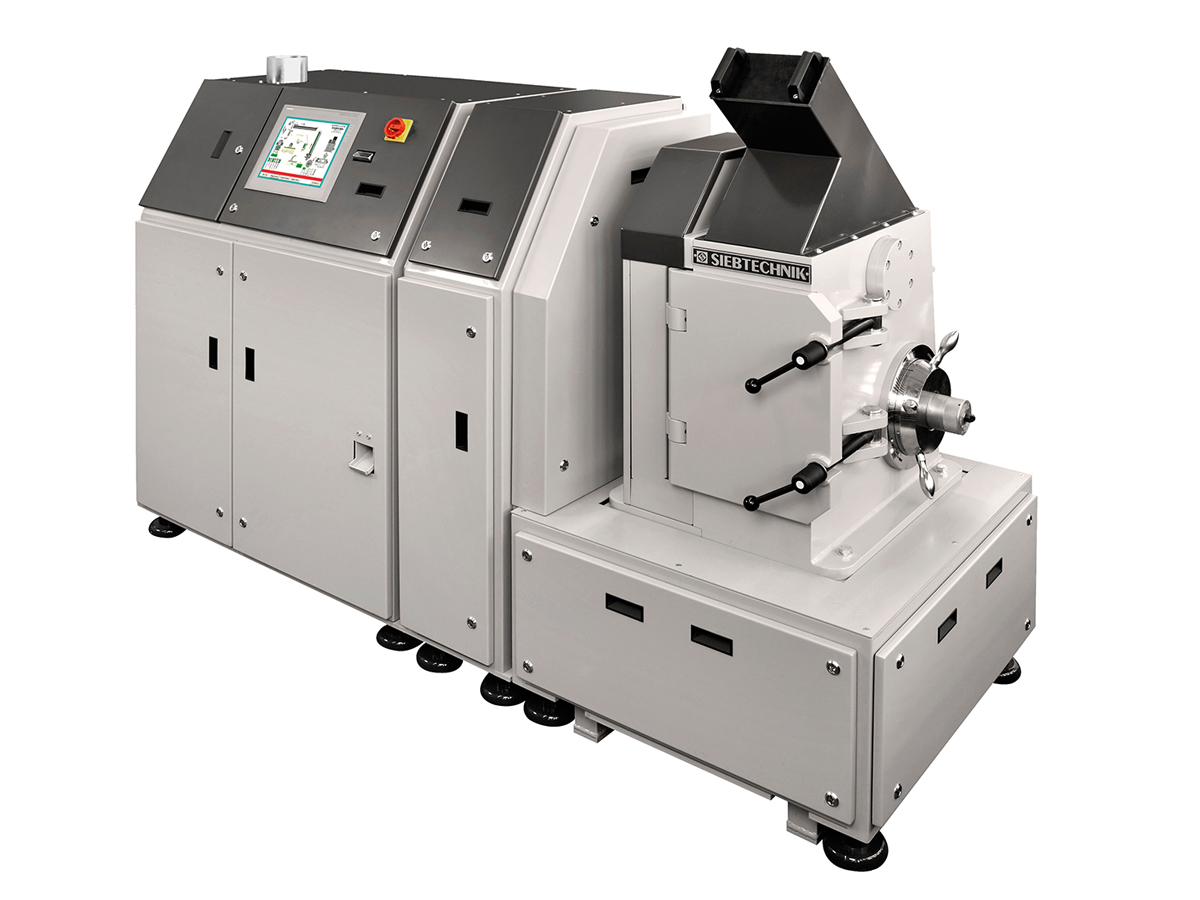Installation automatique de broyage et pastillage AMP
Automatic milling and pressing system AMP
With the fully automatic milling and pressing system, bulk material samples can be transferred into test specimens for an XRF or XRD analyser.
We can offer you a complete solution from the sampling plant and pneumatic tube system right up to automatic sample preparation, including all the machinery and equipment needed.
Operating Behavior & Mechanical Characteristics
Dosing unit
The dosing unit undertakes the volumetric separation of a partial quantity of the delivered bulk material sample for the subsequent principal milling process and production of the test specimen. To begin with, the surplus material not separated from the bulk material sample is used for flush milling.
By the integrated grinding additive dosing unit can be added to the sample material to be ground, depending on the presetting, the required number of grinding additive tablets for flush and main milling.
Vibrating disc mill
Comminution of the bulk material sample takes place in the Laboratory Disc Mill which is time-tested in sample preparation. The mill is equipped with a grinding barrel made of tungsten carbide, optimised for application in AMP. In this manner, once the set grinding period has elapsed, the cylindrical part of the barrel can be lifted from the base for the bulk material sample to be quickly discharged. After grinding, the grinding barrel can be cleaned by the integrated jets.
Press
The fine material received from main milling is pressed into a sample ring by the hydropneumatic cylinder. The cylinder enables the preselected cycle for the pressure build-up, the holding and extraction pressure to be realised. Once the pressing procedure has been concluded, the test specimen is fed to a testing unit. It is here that the pressed tablet is subjected to low-pressure testing, thus ensuring minimum stability of the test specimen.
Cleaning
In order to be able to operate the AMP fully automatically, the components are blown off by compressed-air jets after each milling and pressing process. The contaminated air thus incurred is centralised, via internal dedusting pipes, in a collecting connection on the housing, which has to be connected to an external dedusting system.
Control system
The integrated SPS control system with built-in touch screen makes the machine simple to operate. The varying grinding times, number of grinding additive tablets as well as the pressing parameters are entered and stored by the system. In case of a problem the operator receives clear information to locate the fault quickly – thus ensuring a quick return to automatic operation.
Equipment Options
To prepare drill cores or coarse samples, the automatic milling and pressing system can be extended by a module (-BT), comprising a jaw crusher and a divider.
The Option of this very compact unit will effectively reduce the number of operations for heavy and high volumetric samples.
For this purpose the sample is crushed in a jaw crusher, Type EB 200×125-L, down to approx. 80 % < 2 mm, and reduced in a subsequent divider with integrated scales to the quantity demanded by the AMP.
To increase precision, it can be determined through the AMP control system as to how many partial samples are generated from the initial sample. These partial samples are temporarily stored in a sample carousel until the internal sample transport adds the partial sample from Module–BT to the automatic milling and pressing system.
Technical specification
| Automatische Mahl- und Pressanlage | AMP | -BT | ||
|---|---|---|---|---|
| Abmessungen (B x H x T) | mm | 1100 x 1530 x 750 | 1245 x 1650 x 1120 | |
| Gewicht ca. | kg | 1200 | 1035 | |
| Antriebsleistung | kW | 1,2 | 8,5 | |
| Drehzahl der Mühle | min-1 | 750 - 1300 | ||
| Mahlgefäß | Wolframcarbid | |||
| Brechbacken | Hartstahlguss | |||
| Presswerkzeuge | mm | 51,5x35x8,6 oder 40x32x14 | ||
| Pressdruck (max.) | kN | 187 | ||
| Druckluftverbrauch je Vorgang | Normliter | 300 | 4 | |
| Probenvolumen | cm³ | 50 - 100 | 2000 - 6000 | |
| Max. Aufgabestückgröße | mm | < 6 | < 110 | |
| Vorgänge je Stunde | < 10 | |||
| Die Anzahl der Vorgänge ist abhängig von der Mahldauer und dem Zerkleinerungsverhalten des Brechgutes. Technische Änderungen vorbehalten. | ||||










